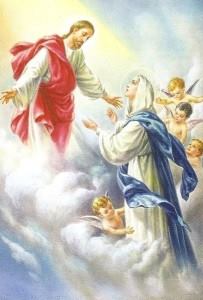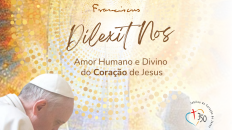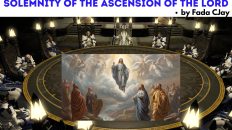A SCRIPTURAL EXPLANATION OF THE ASSUMPTION
OF THE BLESSED VIRGIN MARY, ARK OF THE NEW COVENANT
OF THE BLESSED VIRGIN MARY, ARK OF THE NEW COVENANT
Holy Mother Church celebrates a great feast (solemnity) today; a feast
which gives value to the afterlife of those who believe in God and in His only
son, Our Lord Jesus Christ; put differently, a feast which reminds us that the
faithful shall be “taken up” into the clouds to meet the Lord on the last day (1Thes.
4:17); above all, a feast that has faced many oppositions from the protestants…
This is known as the “Solemnity of the Assumption of the Blessed Virgin Mary”. On
this day, therefore, I will not only present the scriptural explanation, but
will provide logical and coherent grounds for this belief.
which gives value to the afterlife of those who believe in God and in His only
son, Our Lord Jesus Christ; put differently, a feast which reminds us that the
faithful shall be “taken up” into the clouds to meet the Lord on the last day (1Thes.
4:17); above all, a feast that has faced many oppositions from the protestants…
This is known as the “Solemnity of the Assumption of the Blessed Virgin Mary”. On
this day, therefore, I will not only present the scriptural explanation, but
will provide logical and coherent grounds for this belief.
For a conceptual clarity, the doctrine of the Assumption of the
Blessed Virgin Mary should NOT be likened to the popular usage of the term “assume”
or “assuming” etc. On one hand, the word “to assume” means to take something for granted or
to act as if something were true without any proof. If we limit our
understanding to this definition, then, we shall miss out the point. I remember
some time ago, a woman asked me to clarify her on the Assumption of Mary, that,
is it the case that the Church was not sure of the fact that she went up to
heaven and therefore used such words? I tried explaining to her, but she
refused to understand. This is so because, she limited her understanding within
the confines of the definition cited above. Far from that, let us consider what
the word “assumption” means on the other hand. The word assumption comes from
the Latin root “assumptio”, meaning “to be taken up”. St. Paul teaches that we
will be “assumed” (taken up or caught up) into the clouds to meet Jesus at the
last day (see 1Thes. 4:17). I believe the
difference is clearly seen now. Hence, when we talk of the assumption of Mary,
we refer to the fact that she was “taken up” by God to dwell with her beloved
Son, Jesus Christ in heaven. This fact is already prefigured in the book of
Psalms: “Go up, Lord to the place of your rest, you and the Ark of your
strength…” (Ps. 132:8). In this light, the Virgin Mary is understood as the
Ark of the Lord. How are we to understand this?
Blessed Virgin Mary should NOT be likened to the popular usage of the term “assume”
or “assuming” etc. On one hand, the word “to assume” means to take something for granted or
to act as if something were true without any proof. If we limit our
understanding to this definition, then, we shall miss out the point. I remember
some time ago, a woman asked me to clarify her on the Assumption of Mary, that,
is it the case that the Church was not sure of the fact that she went up to
heaven and therefore used such words? I tried explaining to her, but she
refused to understand. This is so because, she limited her understanding within
the confines of the definition cited above. Far from that, let us consider what
the word “assumption” means on the other hand. The word assumption comes from
the Latin root “assumptio”, meaning “to be taken up”. St. Paul teaches that we
will be “assumed” (taken up or caught up) into the clouds to meet Jesus at the
last day (see 1Thes. 4:17). I believe the
difference is clearly seen now. Hence, when we talk of the assumption of Mary,
we refer to the fact that she was “taken up” by God to dwell with her beloved
Son, Jesus Christ in heaven. This fact is already prefigured in the book of
Psalms: “Go up, Lord to the place of your rest, you and the Ark of your
strength…” (Ps. 132:8). In this light, the Virgin Mary is understood as the
Ark of the Lord. How are we to understand this?
In the First Reading (REV
11:19A; 12:1-6A, 10A), John saw the vision of heaven, we were meant to
understand that God’s
temple in heaven was opened, and the ARK OF
HIS COVENANT could be seen in the temple…Hence , a WOMAN clothed with the sun, with the moon under her feet, and on her head a
crown of twelve stars…We were told that She gave birth to a son, a male Child,
destined to rule all the nations with an iron rod…
Dear friends, this scriptural text talks of no other person than the Blessed
Virgin Mary and her Child, Jesus Christ. How are we to understand this? The text begins with the presence of the Ark of the Covenant
in heaven. By the virtue of bearing Christ (who is God) in her womb, it follows
then, that the Virgin Mary is the Ark of the New Covenant (Jesus Christ). Let us
journey through the Scripture in order to understand this.
11:19A; 12:1-6A, 10A), John saw the vision of heaven, we were meant to
understand that God’s
temple in heaven was opened, and the ARK OF
HIS COVENANT could be seen in the temple…Hence , a WOMAN clothed with the sun, with the moon under her feet, and on her head a
crown of twelve stars…We were told that She gave birth to a son, a male Child,
destined to rule all the nations with an iron rod…
Dear friends, this scriptural text talks of no other person than the Blessed
Virgin Mary and her Child, Jesus Christ. How are we to understand this? The text begins with the presence of the Ark of the Covenant
in heaven. By the virtue of bearing Christ (who is God) in her womb, it follows
then, that the Virgin Mary is the Ark of the New Covenant (Jesus Christ). Let us
journey through the Scripture in order to understand this.
In the Old Testament, God made a
covenant with the Israelites on Mt. Sinai through Moses. This is known as
“the Law” contained in two Tablets of Stones. This was usually kept
in an Ark prepared for it (cf. Exd. 25:10-22). Put differently, the Ark is the
dwelling place of the Covenant, (that is its tent). Consequently, in the New
Testament, Jesus Christ is the New Covenant at its core. He embodies everything
the New Covenant is; that is, He is the Word of God and the Son of God, made
human for us. He is the Message of God, etc. Ipso facto, in the very words of
Christ we’ve come to realize it. He says: “This is the cup of my blood,
the blood of the NEW and EVERLASTING COVENANT…” (Cf. Mtt 26:27-28). Having
talked about the New Covenant, it follows then, that we can refer to the
Blessed Virgin Mary as the Ark of the New Covenant, for she was privileged to
provide a fitting dwelling place for our Lord Jesus Christ in her womb. Mary
being the Ark of the New Covenant has a lot of similarities with the Old
Testament Ark that contains the Law written on Tablets of Stones.
covenant with the Israelites on Mt. Sinai through Moses. This is known as
“the Law” contained in two Tablets of Stones. This was usually kept
in an Ark prepared for it (cf. Exd. 25:10-22). Put differently, the Ark is the
dwelling place of the Covenant, (that is its tent). Consequently, in the New
Testament, Jesus Christ is the New Covenant at its core. He embodies everything
the New Covenant is; that is, He is the Word of God and the Son of God, made
human for us. He is the Message of God, etc. Ipso facto, in the very words of
Christ we’ve come to realize it. He says: “This is the cup of my blood,
the blood of the NEW and EVERLASTING COVENANT…” (Cf. Mtt 26:27-28). Having
talked about the New Covenant, it follows then, that we can refer to the
Blessed Virgin Mary as the Ark of the New Covenant, for she was privileged to
provide a fitting dwelling place for our Lord Jesus Christ in her womb. Mary
being the Ark of the New Covenant has a lot of similarities with the Old
Testament Ark that contains the Law written on Tablets of Stones.
When the ark was
completed, the cloud of the Lord (the Shekinah Glory) covered the tent of
meeting, and the glory of the Lord filled the tabernacle (Ex 40:34-35; Nm 9:18,
22). The verb “to cover” or “to overshadow” and the
metaphor of a cloud are used in the Bible to represent the presence and glory
of God. Similarly, when the angel Gabriel was sent by God to the Blessed Virgin
Mary, we were told that he said “The Holy Spirit will come upon you and the power
of the Most High will “overshadow” you (cover you with its shadow) <see Luke
1:35>. This was to give a proof of the Blessed Virgin Mary as the new
dwelling place of God (the Ark of the New Covenant).
completed, the cloud of the Lord (the Shekinah Glory) covered the tent of
meeting, and the glory of the Lord filled the tabernacle (Ex 40:34-35; Nm 9:18,
22). The verb “to cover” or “to overshadow” and the
metaphor of a cloud are used in the Bible to represent the presence and glory
of God. Similarly, when the angel Gabriel was sent by God to the Blessed Virgin
Mary, we were told that he said “The Holy Spirit will come upon you and the power
of the Most High will “overshadow” you (cover you with its shadow) <see Luke
1:35>. This was to give a proof of the Blessed Virgin Mary as the new
dwelling place of God (the Ark of the New Covenant).
When David received the Ark of the Old Covenant, he DANCED for
joy in the presence of the Ark; he said “How can the Ark of God come to
me?” He also left it in the hill country of Judaea for 3 months (cf. 1Sam
6:1-2; 2Sam 6:9-14). Similarly, in the Gospel
Reading of today (Luke 1:39-56), when Elizabeth received Mary (the Ark of
the New Covenant), She was filled with the Holy Spirit, and the baby in her
womb DANCED/LEAPED for joy; She exclaimed: “Blessed are thou among
women…Why is it granted to me that the Mother of my Lord should come to
me?” (This is similar with the statement of David as stated above); and
Mary stayed with her for 3 months (in the hill country of Judaea) – the same
case with the Old Testament Ark as stated above. Hence, we come to understand
that the Ark of the Old Covenant is an allegory to the Ark of the New Covenant
(Mary).
joy in the presence of the Ark; he said “How can the Ark of God come to
me?” He also left it in the hill country of Judaea for 3 months (cf. 1Sam
6:1-2; 2Sam 6:9-14). Similarly, in the Gospel
Reading of today (Luke 1:39-56), when Elizabeth received Mary (the Ark of
the New Covenant), She was filled with the Holy Spirit, and the baby in her
womb DANCED/LEAPED for joy; She exclaimed: “Blessed are thou among
women…Why is it granted to me that the Mother of my Lord should come to
me?” (This is similar with the statement of David as stated above); and
Mary stayed with her for 3 months (in the hill country of Judaea) – the same
case with the Old Testament Ark as stated above. Hence, we come to understand
that the Ark of the Old Covenant is an allegory to the Ark of the New Covenant
(Mary).
Nevertheless, it was fitting that after his ascension
into heaven; Christ judged it worthy that his Blessed Mother (the Ark of the
new Covenant) should also assume (be taken up) body and soul into heaven; that
is why the book of Psalms makes the allusion “Go up, Lord to the place of
your rest, you and the Ark of your strength…” (Ps. 132:8). In this
verse, the Psalmist talks of the ascension of the Lord into heaven and
subsequently, that of the Ark of the Lord, which is better understood as the
Blessed Virgin Mary. Hence, having been in heaven, God gave her the crown of
unfading glory. The First reading says that She was clothed with the sun, with the moon under her
feet, and on her head A CROWN OF
TWELVE STARS. That is why the psalmist today identifies her as the
Queen. This we see in the Responsorial
Psalm: “On your right stands the Queen in garments of Gold” (Ps. 45).
into heaven; Christ judged it worthy that his Blessed Mother (the Ark of the
new Covenant) should also assume (be taken up) body and soul into heaven; that
is why the book of Psalms makes the allusion “Go up, Lord to the place of
your rest, you and the Ark of your strength…” (Ps. 132:8). In this
verse, the Psalmist talks of the ascension of the Lord into heaven and
subsequently, that of the Ark of the Lord, which is better understood as the
Blessed Virgin Mary. Hence, having been in heaven, God gave her the crown of
unfading glory. The First reading says that She was clothed with the sun, with the moon under her
feet, and on her head A CROWN OF
TWELVE STARS. That is why the psalmist today identifies her as the
Queen. This we see in the Responsorial
Psalm: “On your right stands the Queen in garments of Gold” (Ps. 45).
Given the context above, the Church in her wisdom, and guided by the Holy Spirit affirms that She was taken into heaven in the same manner as the Lord – that is, body and soul. Even as the event of Mary being taken up to heaven is not contained in the Scripture; however, the fact remains deeply rooted in the Scripture and could only be understood by the light of Reasoning granted by the Holy Spirit.
For these reasons, on November 1, 1950, Pope Pius XII
defined the Assumption of Mary to be a dogma of faith, he says: “We pronounce, declare, and define it
to be a divinely revealed dogma that the Immaculate Mother of God, the ever
Virgin Mary, having completed the course of her earthly life, was assumed body
and soul to heavenly glory”.
defined the Assumption of Mary to be a dogma of faith, he says: “We pronounce, declare, and define it
to be a divinely revealed dogma that the Immaculate Mother of God, the ever
Virgin Mary, having completed the course of her earthly life, was assumed body
and soul to heavenly glory”.
Dearest friends, this is called the Solemnity of
the Assumption of Mary into heaven and it is celebrated every 15th day of August (TODAY); it is a
holy day of obligation, and all Catholics are obliged to attend Mass.
the Assumption of Mary into heaven and it is celebrated every 15th day of August (TODAY); it is a
holy day of obligation, and all Catholics are obliged to attend Mass.
May the good Lord grant each and every one of us the grace to continue to fight the good fight, so that after the completion of the course of our earthly lives, or at the last day, we might be “taken up” in the clouds to meet the Lord, and be given the crown of unfading glory, Amen.
Happy feast-day to you all…
Shalom!!!




